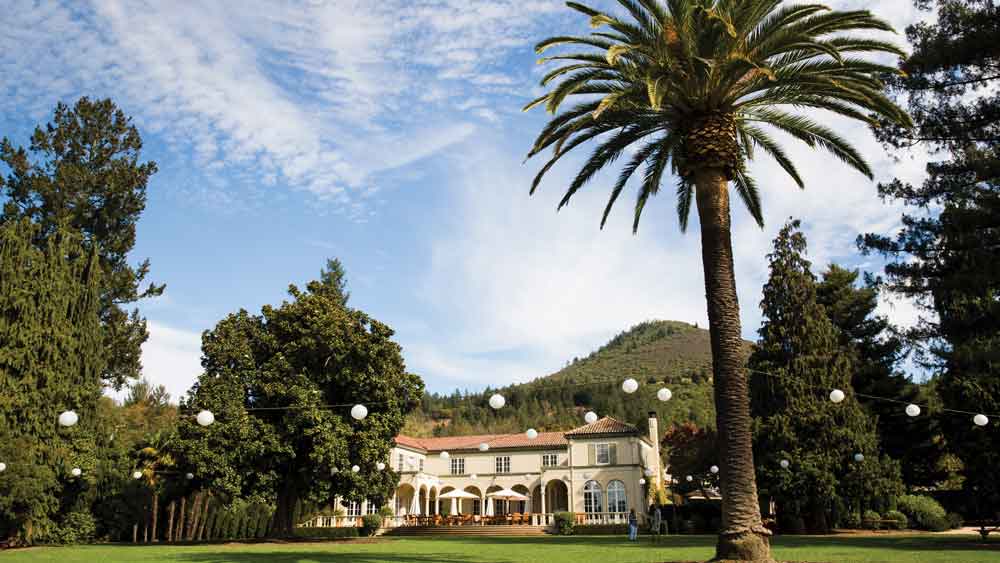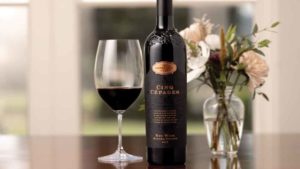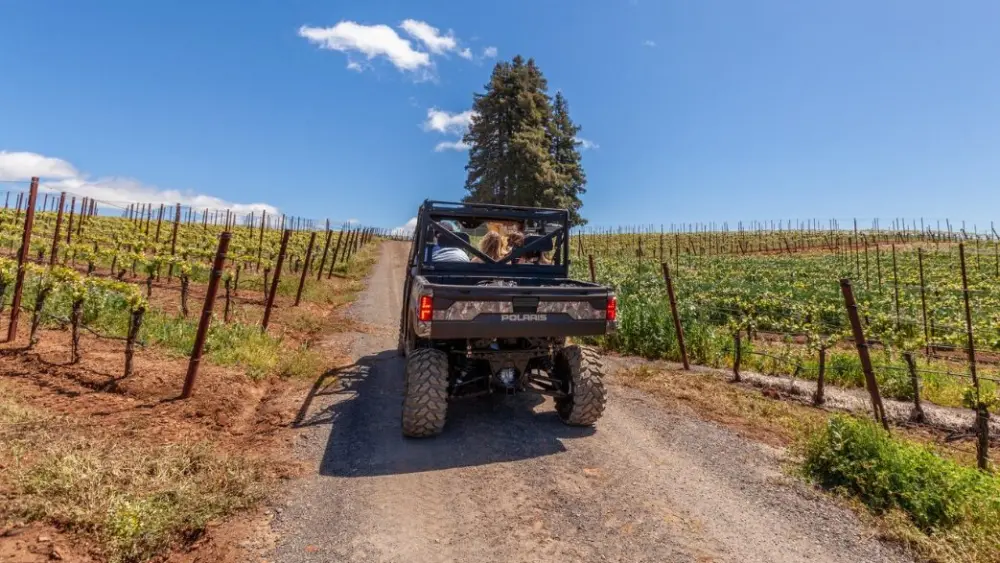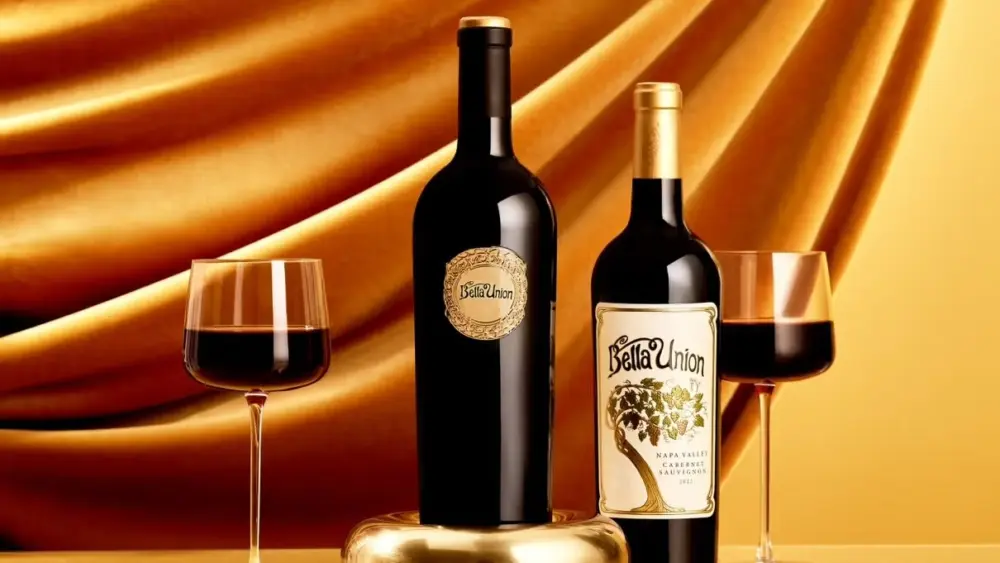
For the many North Bay wineries devastated by fires in recent years, recovery has been a grueling effort. Today, things are looking far more promising. For Kenwood’s Chateau St. Jean Winery, a renaissance is underway, as the company reestablishes its position as a premier winery in the Sonoma Valley.
I arrive for a tasting on a balmy autumn afternoon, and glass of their 2017 Blanc de Noirs is waiting for me in the lobby. I head off with hospitality manager Jourdan Carralejo and winemaker Niki Williams for a tour of the property and lesson on the brand’s history. We walk through the central garden where patrons are tasting, past vibrant clusters of roses and perfectly manicured hedges. Beyond the garden sits the bocce court, the grand lawn (where most of the property’s weddings are held) and the namesake chateau.

Australian wine conglomerate Treasury Wine Estates purchased Chateau St. Jean in 2000, but the winery faced hardship in the wake of the 2017 wildfires, which scorched portions of the property and temporarily closed the winery to visitors and events in an effort to mitigate smoke damage.
In 2021, the winery was purchased by Foley Family Wines. Since the purchase, the gardens have been completely transformed and, for the first harvest season in six years, wine production is back in motion on the Chateau St. Jean property.

Another significant change at the winery is the addition of Williams to the winemaking team. Williams holds a decade of winemaking experience, and this year is her inaugural harvest at Chateau St. Jean. Williams says she admires Foley’s commitment to brand distinction and authenticity, and looks forward to leaving her own mark. “Here, they want us to take ownership of the wines we’re making and make them distinct and different,” she says. “That’s something you don’t always get to do as a winemaker.”
Chateau St. Jean offers five onsite tasting experiences, each allowing optional culinary add-ons, and one virtual tasting option. Williams and Carralejo are guiding me through the Chateau Experience today, which is hosted on the picturesque chateau patio and features five limited-reserve and property-exclusive wines.
We begin with the 2020 Fumé Blanc of the Lyon Vineyard, located in the northernmost part of the Alexander Valley. This wine presents floral aromas and bright, fruity flavors of grapefruit, green apple and apricot. Future vintages will stray slightly from the traditional Fumé Blanc style, which typically is aged in oak, as Williams plans to age it in stainless steel only.
Next, we try the 2019 Gap’s Crown Chardonnay, another single-vineyard wine sourced from the Gap’s Crown Vineyard in the Petaluma Gap AVA. This Chardonnay offers hints of minerality developed from the cool, oceanic climate of the Petaluma Gap. Peach and pear notes complemented by a hint of cinnamon and white pepper create a rich yet balanced mouth-feel.

Between sips, Williams talks about the approachability of wine and believes that everyone should be encouraged to explore and discover wines they enjoy. “We believe in fostering an entire attitude of inclusivity,” says Williams. “Wine is about hospitality and fellowship, and our industry works best when we can make wine accessible and not intimidating.
We transition to reds, tasting the 2017 Grace Benoist Vineyard Pinot Noir. These grapes will eventually be replaced by another single-vineyard Pinot. Grown in the Carneros region, the cooler climate is optimal for growing Pinot grapes. This wine tastes of juicy cherry and blackberry, with touches of black tea and clove.
Next, we try the 2018 Malbec, whose grapes are also sourced from the Alexander Valley, with 94% Malbec and 6% Cabernet Sauvignon to create deep color and a vivid, fruity aroma. Williams highlights that the dark berries of the Malbec soften the boldness of the Cab, creating a balanced acidity and satisfying finish.

Our tasting concludes with the flagship wine, the 2016 Cinq Cépages Bordeaux blend, which has justly earned its prestige as the brand’s premier wine. Present are five varieties, or “cing cépages,” including Cabernet Sauvignon, Merlot, Cabernet Franc, Malbec and Petit Verdot. This vintage tastes impressively bold and rich, with layered notes of cassis, black licorice and sweet blueberry.
Despite recent challenges, Chateau St. Jean’s ongoing evolution demonstrates the winery’s resilience and fortitude as a major brand. They have weathered the storm, and now, can continue doing what they do best: making world-class wines and serving the Sonoma Valley and beyond.
Cheers to Chateau St. Jean, and their bright future ahead.
At a Glance
Chateau St. Jean
8555 Sonoma Hwy, Kenwood, CA
95452
Hours: Daily from 10 a.m. to 5 p.m.
Tasting Fee: $45-$85 per person
Wines Offered: 2020 Fumé Blanc, 2019 Gap’s Crown Chardonnay, 2017 Pinot Noir, 2018 Malbec, 2016 Cinq Cépages.
Reservations: Preferred, but not required
Picnics: No
Pets: Yes, on a leash.
Did You Know?
Some wineries use egg, milk, fish or gelatin-based agents in their “fining,” a process that removes unwanted “colloids” such as tannins, phenolics or polysaccharides from the wine. But CSJ winemaker Niki Williams keeps all of her wines animal-product free. Vegan wines have gained popularity in recent years, and since wines do not have ingredient lists on their labels, it can be hard to tell if a wine is vegan or not.



